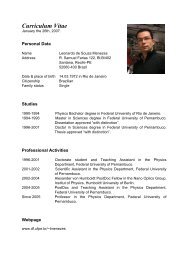Download Abstracts Book - DF-UFPE Pessoal
Download Abstracts Book - DF-UFPE Pessoal
Download Abstracts Book - DF-UFPE Pessoal
You also want an ePaper? Increase the reach of your titles
YUMPU automatically turns print PDFs into web optimized ePapers that Google loves.
ORAL CONTRIBUTIONS<br />
Penetration of magnetic field in type II superconductors studied by<br />
time dependent Ginzburg-Landau equation<br />
Isaias G. de Oliveira<br />
Departamento de Física, Universidade Federal Rural de Rio de Janeiro BR-465, km 7, CEP<br />
2389-000, Seropedica, Rio de Janeiro, Brazil<br />
The time-dependent Ginzburg-Landau (GL) equation is solved numerically for type-II<br />
superconductors using the finite element method [1][2]. The size of the mesoscopic<br />
sample, the GL parameter, and the applied magnetic field have a marked influence on<br />
the petration of the magnetic field, the magnetic vortex distribution and the vortex<br />
dynamics. In this workshop I will present different behaviors of magnetic field<br />
penetration in superconductors:<br />
1. For large sample (Lx = 100λ and Ly = 50λ) with ĸ = 4, and subjected to an<br />
uniform magnetic field H = 1.5H c2 . The initial penetration of magnetic field<br />
presents usual penetration behavior. After few times the penetration of magnetic<br />
field presents a new behavior, when so, appear small structures: the magnetic<br />
fingers. They increace until there exist nucleation of vortices on the top of these<br />
fingers. The magnetic fingers structure are destroyed however it returns to<br />
increace again. The vortices nucleated are driven to the centre of the sample<br />
pushed by the giant vortices fingers.<br />
2. For a mesoscopic superconductor square with slit and hole [3]. In this case I<br />
have studied the vortices penatration for different values of _ and applied<br />
magnetic field. For soft type II superconductors (for instance, ĸ = 3) there are a<br />
penatration of multivortices and the system find the stability so fast. Otherwise,<br />
for extremely hard superconductors (for instance, ĸ = 20), there are nucleations<br />
of multivortices and also appear giants vortices in the corners of the hole. From<br />
these giants vortices in the corners multivortices are nucleated.<br />
3. Presence of defects. To illustrate the dynamics of vortices entering a defect in a<br />
square shaped type-II superconductor, I will present the time evolution of<br />
vortices for different values of ĸ and applied magnetic field. The applied field is<br />
kept constant, after the system arrive in a stable configuration the magnetic field<br />
is inverted. By this time we can see three simultaneous effects: penetration of<br />
anti-vortices, expelling of vortices and annihilation of vortex and anti-vortex.<br />
[1] The software Comsol 3.5a and MatLab have been used for numerical calculations.<br />
[2] T.S. Alstrøm et al., Acta Appl Math DOI 10.1007 , August 2010.<br />
[3] E. H. Brandt, Journal of Low Temperature Physics, Vol. 130, Nos. 3/4,<br />
February 2003<br />
33






